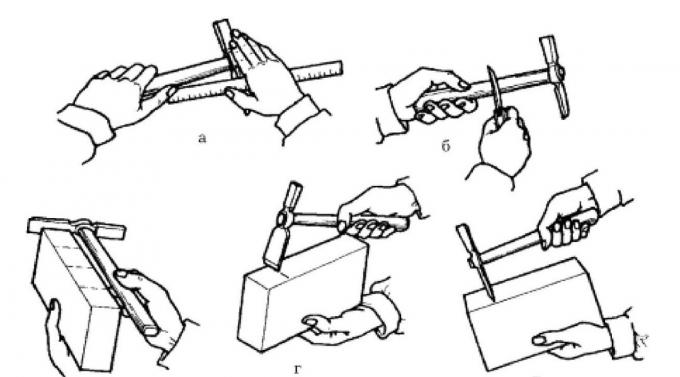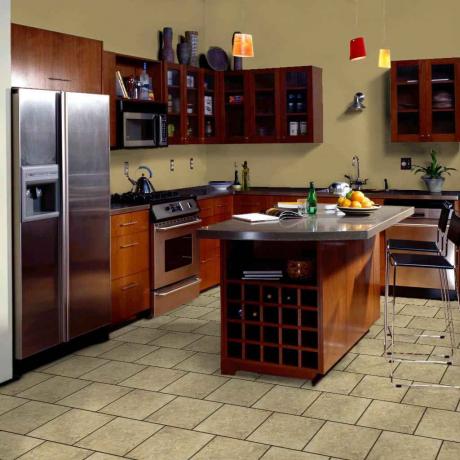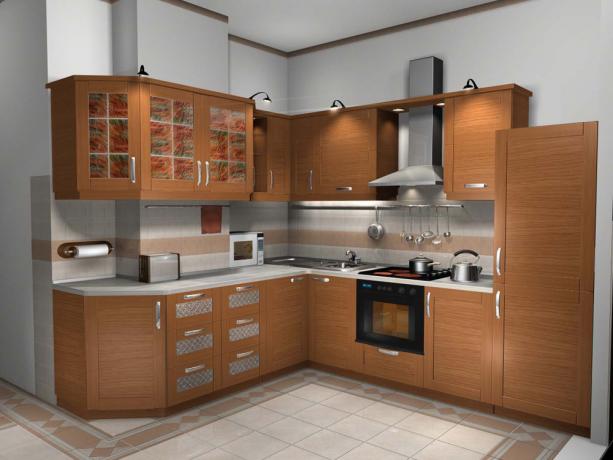Content
-
1 What can be done with the refrigerator under the window
- 1.1 Positive and negative sides of the refrigerator under the window
- 1.2 How to deepen the niche under the window yourself
- 1.3 Refrigerator doors
- 1.4 Dismantling the refrigerator under the window
- 2 Conclusion
It is interesting that the refrigerator in the kitchen under the window can have a variety of definitions in the name, and this will depend not on its functionality, but on the region or area where it was equipped.
So, in Kolyma it will be a Kolyma refrigerator, in Magadan - a Chukchi refrigerator, in Sverdlovsk - a Ural refrigerator, and those who managed to live under the unforgettable Nikita Sergeevich call it Khrushchev. Nevertheless, such a device serves the same purposes regardless of the region in which it was made.
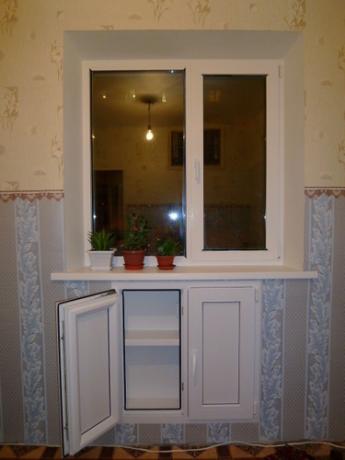
Kolyma refrigerator
What can be done with the refrigerator under the window
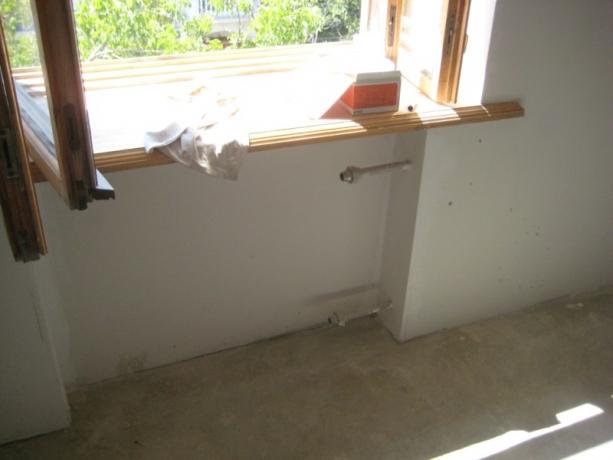
Niche under the window
In the houses built under the N. FROM. Khrushchev and in some other, less popular projects, a niche is provided under the windows for radiators (obviously in order to save space).
But, as you know, the Soviet people were inventive, and in this place, having shifted the heating battery to the side, some equipped a winter refrigerator, the cooling principle of which consisted of a thinner wall and cooling it down in cold weather of the year. Such a device has its positive and negative aspects, which we will consider below.
Refrigerator in the kitchen - see here.
Positive and negative sides of the refrigerator under the window

The radiator is shifted away from the refrigerator
- A cabinet in a niche under the window, which performs the functions of a refrigerator or cellar in winter, is useful for saving space in an apartment or closet. The average wall thickness of the house is 60 cm, and the design recess of the niche is 15 cm, and therefore this part of the wall is much colder.
- In houses of this type, well masonry is usually used, where slag is poured into the voids as a heater. Considering the peculiarities of this masonry and the type of filler, the wall in this area can be made even thinner by knocking down the plaster and disassembling a number of bricks.
- But radiators are specially installed under the windows - this is required by the instruction, because in this case they are most effective. Warm air from the battery, rising upward, creates a kind of invisible insulation, blocking the path of cold streams from the side of the window glass. Therefore, if you move the radiator to the side, then you seem to take off the transparent blanket and open the way for the cold.
Read also the article on the location of the refrigerator in the kitchen.
How to deepen the niche under the window yourself

Having disassembled part of the masonry, you can deepen the niche
- Let's try to make a refrigerator in a niche under the window with our own hands, and for this, first of all, we need to knock down the plaster to get to the masonry. If we go deeper, then do not be afraid of the fact that this is a load-bearing wall, because that part which under the window has nothing to do with this - there is a concrete lintel above the window, which preserves the integrity of the carrier element.

Well masonry
- In the schematic drawing, you see the principle of well masonry - something like this looks like a cross-section of the wall of your house, only the voids are filled with slag to insulate the house. If you wish, you can deepen the niche by disassembling part of the masonry that is inside the house, making the wall thinner by another 20-25 cm, then in the remainder you will get only 25 cm, but you can also thinner.

Brick sides
- In order to make it easier for you to navigate the thickness of the wall, take into account the parameters of the brick, for example, a brick always has 250 mm in length, and 120 mm in width (along the bed). Only its thickness changes (the height of the poke and the spoon): a single brick has a thickness of 65 mm, a one-and-a-half brick - 88 mm and a double one - 138 mm. But, in this case, the width and length are important for you in order to understand what will remain in the wall thickness when disassembling a part of the masonry.
- Suppose you disassembled the inside of the masonry, knocking down parts of the bricks laid with a poke (across the masonry), in this case you have only the width of the brick will remain, but the remaining partition must necessarily be plastered with cement-sand mortar (not putty!). When dismantling the masonry, cracks and gaps may form on the outside, through which moisture can penetrate, which will freeze in winter and tear off the putty on the inside of the wall. After the cement, you can putty the wall with a thin layer, and immediately using satengips (finishing putty).

Inside the refrigerator can be tiled with ceramic tiles
- But a device like our makeshift outdoor refrigerator will have one major drawback - condensation on the walls. This will happen due to the temperature difference between the room and the outside, because the thin partition on the outside will be cold. Therefore, in order to facilitate the maintenance of our refrigerator, it can be tiled inside with ceramic tiles.
- It is best to install the tiles on a plaster base using tile adhesive. If you live in the northern regions of Russia and subzero temperatures are possible in this cabinet, then it is better to use universal frost-resistant glue for laying. For example, the mixture Ceresit CM 11 has not yet caused any complaints.
Council. You do not need to puzzle over which tiles to choose for the interior lining of the refrigerator - the most basic requirement for tiles in this case will be its smooth surface. Therefore, without any doubt, you can purchase the cheapest and even defective tiles, as well as use waste, for example, the remains from bathroom renovations.
Read also the article "Refrigerator for a small kitchen - what to do when every centimeter counts."
Refrigerator doors

Refrigerator front
- Of course, if the refrigerator doors are identical to the kitchen facades, then this will be the best option for the interior of the room and if you made a headset to order, then it costs you nothing to order some of its parts separately. You can even negotiate with furniture makers for installing facades on the refrigerator - this, of course, has its own price, but the work will be done by professionals.

Standard facade markings
- To hang doors on a makeshift refrigerator, we need straight niche edges, where each of the corners will have 90⁰. Such parameters can be achieved with the help of ceramic tiles, or make a wooden frame frame for hanging facades. You can hide the split of the frame with the edges of the niche from the outside with some kind of baguette, which will look quite natural and beautiful.
- In order for an improvised refrigerator to keep the temperature, it must be well closed, which means that the doors must fit snugly together. Such an opportunity is provided only with the correct hanging of the facades.
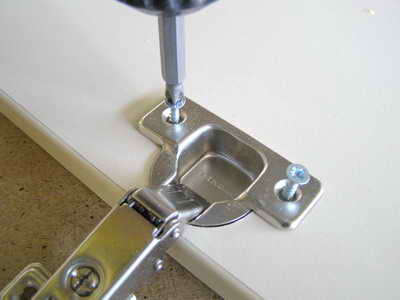
Installing the hinge in the groove
- The center of the hinge groove should be at a distance of 21-22 mm from the corner edge of the facade (adjustable according to the door thickness). From the end edge to the center of the landing, the hinges are usually left from 70 to 120 mm (depending on the size of the door and personal preferences). If such panels turn out to be very heavy, then you can add a third loop in the middle, but you need to calculate the distance between the awnings so that they do not fall on the shelves in the refrigerator.
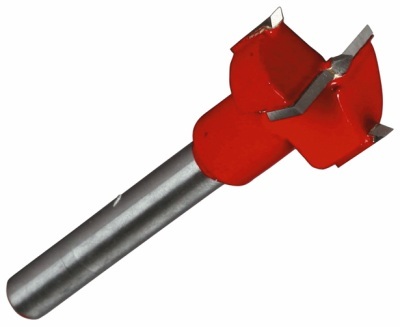
End mill for wood
- For inserting the hinges, a wood end mill is used, and for a seat its diameter will be 35 mm. The depth of the groove is 12-13 mm, and the thinnest furniture panel is 16 mm (maybe 18 mm), so care must be taken when drilling so that the center of the cutter does not go right through. This will be facilitated by a good sharpening of the drill - when working, you do not need to press hard on the panel and therefore it is easier to adjust the depth.
- For work, you will definitely need an awl, which you will use as a center punch in order to prevent the cutter or self-tapping screws from slipping. So, you will need to screw the center of the canopy seats, as well as the places for screwing the screws into their fastening.
- The other part of the hinges can be attached directly to the ceramic tile (if you made a niche with right angles) using screws and dowels. In this case, it is very important to drill the tiles for the dowels with high accuracy, so mark the places drilling with a pencil or marker, and then make a test hole with a victor drill with a diameter of 3 mm. Use dowels with a thickness of 5-6 mm, only the screws for them should be no thinner than 3-4 mm, so that the facades hold well.
- For a device such as a Khrushchev refrigerator, it is not at all necessary to use furniture facades - you can use a wooden frame with plastic in the middle, as in the photo above. But in this case, you should remember that wood is a good thermal insulator and will keep the temperature in the refrigerator, while the plastic is too thin for this and will have to be extended with something like foam or extruded expanded polystyrene.

The door is equipped with a false strip
- Pay attention to the edge of the door, which is in the top photo - a groove is selected along the perimeter and you get something like a false plank. For a refrigerator, this is not the least important, because such a device increases the tightness, and, therefore, keeps the cold. Even if you have custom-made furniture doors, you can equip them with a narthex by making it from a suitable molding.
Dismantling the refrigerator under the window
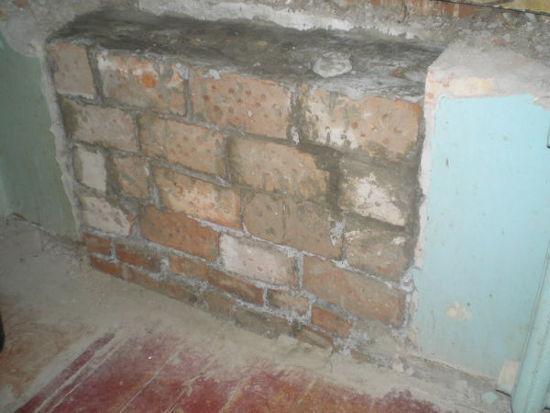
Niche laying with old brick
- It may also happen that you decide to abandon the refrigerator under the window because you have additional options for storing food or for some other reason. In this case, it is best for you not just to close the niche with the same drywall, but to lay it with bricks or blocks (gas blocks, foam blocks).
Recommendation. If you dismantled the refrigerator under the window, then it is advisable to return the radiator to its original place in order to increase its efficiency. As mentioned above, this will create a barrier to cold streams from the window glass.

A radiator under a window will do more good than a radiator away from it
- When laying a niche in the place of a former refrigerator, you should consider whether you will rearrange the radiator. If so, then it is better to use ordinary brick, even if it is old or halved - it is much stronger and easier to install battery brackets in it.
- If the niche is deep, you don't have to fill it completely - just drive it into the opposite the wall pieces of reinforcement for bundling, and between the two partitions pour slag or small construction trash. You will not be able to pour the filler all the way to the window sill, so the remaining space can be filled with polyurethane foam.
How to build a refrigerator into a kitchen set - see here.
Conclusion
It is unlikely that you will find in any photo or video presentation of an apartment such a device as the refrigerator described above. But do not forget that we make presentations in the European way, but we live as before, in the Soviet way, using a variety of possibilities for everyday life. Good or bad - you decide for yourself!
